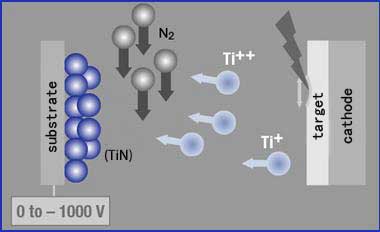
What is arc evaporation?
One form of physical vapour deposition (PVD coating) is arc evaporation. The history of PVD coating started using arc technology, which has its origin in arc welding.
Targets
The metal to be evaporated is placed as solid block (target) against the inside of a vacuum chamber. A glow discharge is ignited and runs on the target, leaving a footprint. Small spots of a few µm diameter target material are evaporated. The movement of the arc can be guided by magnets.
Plasma coating
The evaporated, ionized material is used as plasma coating on a product which rotates inside the vacuum chamber. Arc coatings are e.g. used as tool coating and component coating.
Examples of coatings
Examples of arc coating are TiN, AlTiN, AlCrN, TiSiN, TiCN, CrCN and CrN coating

Schematic view of a PVD arc process.
Arc coating technology is characterized by:
The main disadvantages of arc coating technology are: